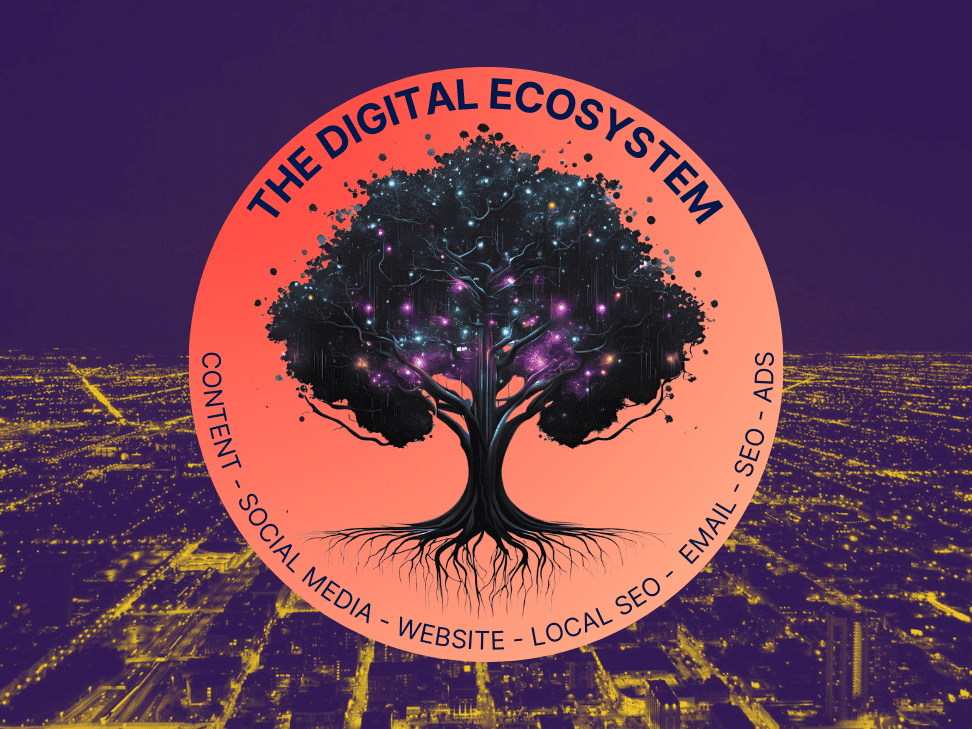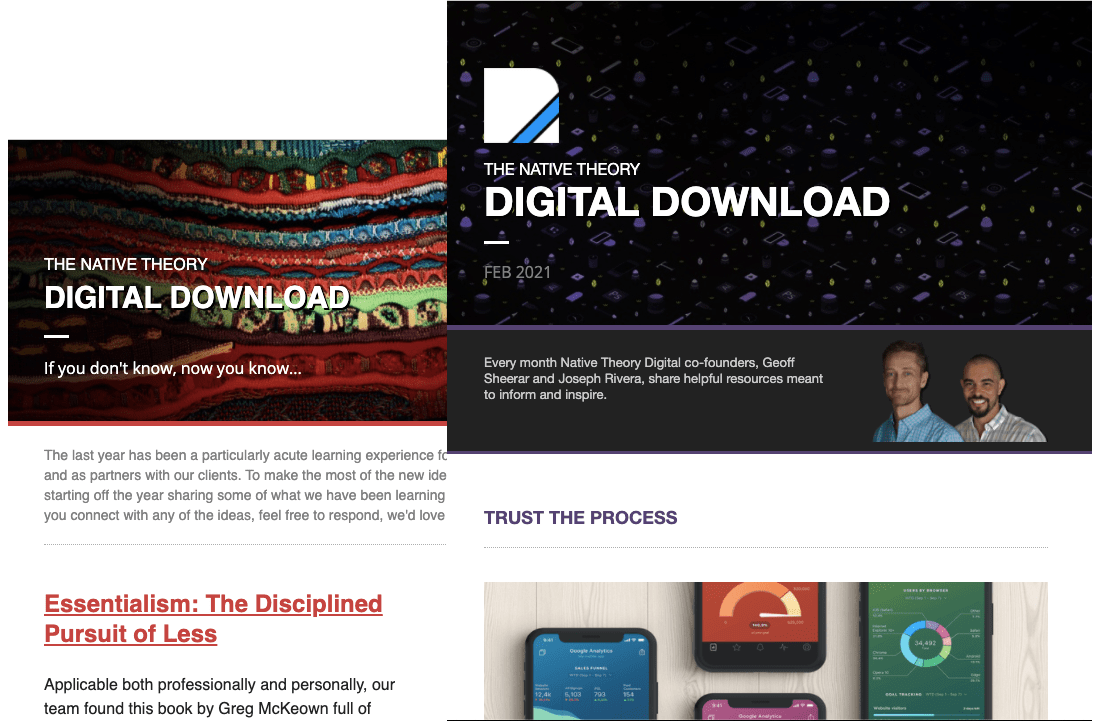Your business’s online presence is more than just a website or social media page—it’s an interconnected ecosystem that represents your brand and organization. This ecosystem can either pull your business forward or hold it back. Is your Digital Ecosystem working for or against your business?
The Digital Ecosystem and Why It Matters
The Digital Ecosystem is the web of interconnected components, like roots of a tree, that make up your business’s online presence. It includes your website and social media, as well as your local business listing, content and emails that you use to communicate with your target customers and clients.
These components don’t function in isolation—they can work together to support the goals of your organization and help it flourish. Whether that means attracting new customers, retaining existing clients, or even just building an email list. A properly optimized ecosystem with a customized strategy behind it helps raise the chances of success, including focus on consistent branding, thoughtful communication, and measurable results.
Key benefits of a healthy Digital Ecosystem include:
- Customer Journey Optimization: Promotes seamless transitions from awareness to conversion across touchpoints.
- Operational Efficiency: Minimizes redundancies and conflicting points. Aids in maximizing ROI.
- Strategic Insights: Provides actionable data to guide decision-making.
Core Components of a Digital Ecosystem
A successful Digital Ecosystem includes the following elements:
1. Website: Your Digital Foundation
- Acts as the central hub for all the digital properties of your online presence.
- Establishes credibility and provides a user-friendly experience.
- Enables lead capture through forms, downloads, and calls to action.
2. Local Search Engine Optimization (SEO): Being Found Locally
- Improves visibility for location-based searches.
- Leverages platforms like Google My Business for reviews and maps.
- Drives traffic from nearby customers actively seeking your services.
3. Content Marketing: Building Trust and Engagement
- Delivers value through blogs, videos, and other formats.
- Positions your business as an authority in your industry.
- Boosts SEO by targeting relevant keywords.
4. Social Media: Connecting Authentically
- Facilitates direct interaction with customers.
- Amplifies brand messaging through shares and comments.
- Supports campaigns with organic and paid strategies.
5. Email Marketing: Staying Top of Mind
- Builds long-term relationships with your audience.
- Personalizes communication based on user behavior.
- Drives engagement with exclusive offers and updates.
6. Online Ads: Targeting with Precision
- Reaches specific demographics through platforms like Google Ads and Facebook Ads.
- Enhances brand visibility and drives traffic.
- Provides measurable ROI with detailed performance metrics.
7. Data Analytics and Reporting: Measuring What Matters
- Tracks key metrics to assess campaign effectiveness.
- Identifies trends and opportunities for improvement.
- Supports data-driven decision-making for sustained growth.
Is Your Digital Ecosystem Helping or Hindering Your Organization’s Growth?
A well-functioning ecosystem supports your business goals, but how can you tell if yours is helping or holding you back?
Look for these signs:
Red Flags
- Inconsistent User Experience Across Platforms: Different designs, messaging, or functionalities across your website, social media, and other channels.
- Limited or No Tracking of KPIs: Lack of data on performance metrics like click-through rates, engagement, or conversions.
- Outdated Content: Blogs, pages, or campaigns with stale information that no longer align with your brand or audience needs.
- Fragmented Social Media Strategy: Posting inconsistently or failing to engage with your audience in meaningful ways.
- Minimal Organic Traffic: Reliance solely on paid ads due to poor SEO performance.
- Low Email Open or Click-Through Rates: Indicates ineffective targeting or messaging.
- High Bounce Rates on Landing Pages: Indicates that visitors are not engaging or finding what they need.
- No Automation in Place: Manual processes slowing down productivity and limiting scalability.
- Inefficient Ad Spend: Spending heavily on ads without seeing proportional results.
- Slow Website Load Times: Frustrates visitors and negatively impacts search engine rankings.
Opportunities for Growth
- Implementing Consistent Branding: Create a unified look and feel across all platforms for trust and recognition.
- Optimizing Website Performance: Improve load speeds, mobile responsiveness, and overall user experience.
- Refreshing Content Strategies: Regularly update blogs, videos, and marketing assets to reflect current trends, audience preferences and cohesive messaging.
- Enhancing Landing Pages: Use A/B testing to refine headlines, CTAs, and layouts to increase conversions.
- Adopting Comprehensive Analytics Tools: Use platforms like Google Analytics to monitor online performance and optimize underperforming campaigns.
- Strengthening Organic Traffic: Use SEO tactics like keyword optimization, backlink building, and local search enhancements to grow visibility.
- Personalizing Email Campaigns: Leverage audience segmentation and behavioral triggers to improve relevance and engagement.
- Streamlining Ad Strategies: Allocate budgets to high-performing channels, optimize targeting, and refine creatives.
- Expanding Social Media Presence: Engage your audience with authentic content, regular updates, and interactive campaigns.
- Integrating AI and Automation: Use advanced tools to simplify workflows, predict trends, and deliver tailored experiences at scale.
Enhancing Your Digital Ecosystem
Once you’ve identified red flags and opportunities for growth through a thorough health check, it’s time to take intentional steps to enhance your digital ecosystem. By focusing on strategic improvements and leveraging modern tools, you can create a cohesive and efficient system that drives meaningful results.
Evaluate Your Current Ecosystem
Building on the insights from your health check, take a deeper dive into each component of your digital ecosystem:
- Audit Each Element: Assess the performance of your website, SEO, content marketing, social media, email campaigns, ads, and analytics. Pinpoint underperforming areas or gaps where improvement is needed.
- Understand User Experience: Use surveys, customer feedback, and tools like heatmaps or user testing to gain actionable insights into how customers engage with your platforms.
- Prioritize Key Fixes: Focus first on high-impact areas, such as fixing technical SEO issues, updating outdated content, or improving slow-loading pages.
Integrate Automation and AI Tools
Automation and artificial intelligence (AI) are critical for scaling your digital ecosystem while maintaining efficiency:
- Streamline Repetitive Tasks: Automate processes like email campaigns, social media posting, and lead nurturing to save time and reduce manual errors.
- Enhance Personalization: Leverage AI-driven tools to deliver tailored customer experiences, such as product recommendations, dynamic email content, or targeted ads.
- Predict Trends and Behaviors: Use AI-powered analytics tools to identify emerging trends, predict customer behaviors, and optimize future strategies.
Leverage Data Analytics for Continuous Improvement
Data is the backbone of an effective digital ecosystem. By consistently analyzing and acting on your metrics, you can refine your strategy and maximize ROI:
- Set Clear KPIs: Define measurable goals for each element of your ecosystem, such as increasing website conversions, improving email click-through rates, or boosting ad ROI.
- Review Reports Regularly: Use platforms like Google Analytics, SEMrush, and HubSpot to monitor performance and spot trends. Analyze metrics like traffic sources, bounce rates, and conversion rates.
- Optimize Through Testing: Conduct A/B testing on campaigns, website layouts, and CTAs to identify what resonates best with your audience. Use these insights to refine your approach and achieve better results.
Don’t let a fragmented Digital Ecosystem hold your business back from flourishing. By taking these steps, you’ll ensure your Digital Ecosystem not only supports your business goals, but helps to drive growth. A well-optimized Digital Ecosystem can become a self-sustaining engine for customer acquisition, retention, and long-term success.
Start by evaluating your current setup and identifying areas for improvement. If you’re ready to take your results to the next level, Native Theory Digital can help. Let’s optimize your Digital Ecosystem so it works for your business—not against it.




